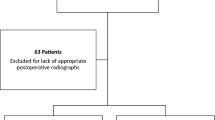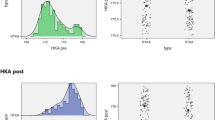Abstract
Robot-assisted total knee arthroplasty (TKA) has proven to be successful in improving the accuracy of component positioning and reducing radiographic outliers. This study aimed to evaluate and compare the alignment of the components using two- and three-dimensional (2D and 3D) measurements following handheld imageless robot-assisted TKA. Seventy consecutive patients underwent primary TKA at our institution using a handheld robot-assisted system. Full‐length standing anteroposterior and lateral radiographs were obtained 2 weeks after surgery for assessment of 2D component alignments. Pre- and postoperative computed tomography (CT) images were obtained to assess 3D component alignment. The reference points defined on preoperative CT images were transferred to the postoperative CT images. The absolute errors in the 2D and 3D component alignments from the planned, validated cutting, and validated implantation angles were calculated. Outliers of > ± 3° of femoral and tibial component alignments in the coronal and sagittal planes were also investigated. All absolute errors in the 2D and 3D component alignments were < 1°, except for the planned and validated cutting angles of the femoral sagittal alignment. No outliers were observed in the femoral or tibial component in the coronal plane. Significant differences between the 2D and 3D measurements were observed for the mean absolute value from the planned and validated cutting angles in the femoral sagittal plane and from the validated implantation angle in the tibial coronal plane. The handheld robot-assisted system demonstrated a high accuracy for component alignment using 2D and 3D evaluations.

Similar content being viewed by others
Data availability
The data that support the findings of this study are available from the corresponding author upon reasonable request.
References
Collier MB, Eickmann TH, Sukezaki F, McAuley JP, Engh GA (2006) Patient, implant, and alignment factors associated with revision of medial compartment unicondylar arthroplasty. J Arthroplasty 21(Supplement 2):108–115. https://doi.org/10.1016/j.arth.2006.04.012
Hernigou P, Deschamps G (2004) Alignment influences wear in the knee after medial unicompartmental arthroplasty. Clin Orthop Relat Res 423:161–165. https://doi.org/10.1097/01.blo.0000128285.90459.12
Parratte S, Pagnano MW, Trousdale RT, Berry DJ (2010) Effect of postoperative mechanical axis alignment on the 15-year survival of modern, cemented total knee replacements. J Bone Jt Surg Am 92:2143–2149. https://doi.org/10.2106/JBJS.I.01398
Rand JA, Trousdale RT, Ilstrup DM, Harmsen WS (2003) Factors affecting the durability of primary total knee prostheses. J Bone Jt Surg Am 85:259–265. https://doi.org/10.2106/00004623-200302000-00012
Berend ME, Ritter MA, Meding JB, Faris PM, Keating EM, Redelman R, Faris GW, Davis KE (2004) Tibial component failure mechanisms in total knee arthroplasty. Clin Orthop Relat Res 428:26–34. https://doi.org/10.1097/01.blo.0000148578.22729.0e
Liu HX, Shang P, Ying XZ, Zhang Y (2016) Shorter survival rate in varus-aligned knees after total knee arthroplasty. Knee Surg Sports Traumatol Arthrosc 24:2663–2671. https://doi.org/10.1007/s00167-015-3781-7
Lonner JH, Fillingham YA (2018) Pros and cons: a balanced view of robotics in knee arthroplasty. J Arthroplasty 33:2007–2013. https://doi.org/10.1016/j.arth.2018.03.056
Werner SD, Stonestreet M, Jacofsky DJ (2014) Makoplasty and the accuracy and efficacy of robotic-assisted arthroplasty. Surg Technol Int 24:302–306
Deckey DG, Rosenow CS, Verhey JT, Brinkman JC, Mayfield CK, Clarke HD, Bingham JS (2021) Robotic-assisted total knee arthroplasty improves accuracy and precision compared to conventional techniques. Bone Jt J 103B(Supplement A):74–80. https://doi.org/10.1302/0301-620X.103B6.BJJ-2020-2003.R1
Elliott J, Shatrov J, Fritsch B, Parker D (2021) Robotic-assisted knee arthroplasty: an evolution in progress. A concise review of the available systems and the data supporting them. Arch Orthop Trauma Surg 141:2099–2117. https://doi.org/10.1007/s00402-021-04134-1
Seidenstein A, Birmingham M, Foran J, Ogden S (2021) Better accuracy and reproducibility of a new robotically-assisted system for total knee arthroplasty compared to conventional instrumentation: a cadaveric study. Knee Surg Sports Traumatol Arthrosc 29:859–866. https://doi.org/10.1007/s00167-020-06038-w
Sires JD, Craik JD, Wilson CJ (2021) Accuracy of bone resection in MAKO total knee robotic-assisted surgery. J Knee Surg 34:745–748. https://doi.org/10.1055/s-0039-1700570
Liow MH, Xia Z, Wong MK, Tay KJ, Yeo SJ, Chin PL (2014) Robot-assisted total knee arthroplasty accurately restores the joint line and mechanical axis A prospective randomised study. J Arthroplasty 29:2373–2377. https://doi.org/10.1016/j.arth.2013.12.010
Casper M, Mitra R, Khare R, Jaramaz B, Hamlin B, McGinley B, Mayman D, Headrick J, Urish K, Gittins M, Incavo S, Neginhal V (2018) Accuracy assessment of a novel image-free handheld robot for total knee arthroplasty in a cadaveric study. Comput Assist Surg (Abingdon) 23:14–20. https://doi.org/10.1080/24699322.2018.1519038
Bollars P, Boeckxstaens A, Mievis J, Kalaai S, Schotanus MGM, Janssen D (2020) Preliminary experience with an image-free handheld robot for total knee arthroplasty: 77 cases compared with a matched control group. Eur J Orthop Surg Traumatol 30:723–729. https://doi.org/10.1007/s00590-020-02624-3
Vaidya NV, Deshpande AN, Panjwani T, Patil R, Jaysingani T, Patil P (2022) Robotic-assisted TKA leads to a better prosthesis alignment and a better joint line restoration as compared to conventional TKA: a prospective randomized controlled trial. Knee Surg Sports Traumatol Arthrosc 30:621–626. https://doi.org/10.1007/s00167-020-06353-2
Vaidya N, Jaysingani TN, Panjwani T, Patil R, Deshpande A, Kesarkar A (2022) Assessment of accuracy of an imageless hand-held robotic-assisted system in component positioning in total knee replacement: a prospective study. J Robot Surg 16:361–367. https://doi.org/10.1007/s11701-021-01249-w
Savov P, Tuecking LR, Windhagen H, Ehmig J, Ettinger M (2021) Imageless robotic handpiece-assisted total knee arthroplasty: a learning curve analysis of surgical time and alignment accuracy. Arch Orthop Trauma Surg 141:2119–2128. https://doi.org/10.1007/s00402-021-04036-2
Kaneko T, Igarashi T, Takada K, Yoshizawa S, Ikegami H, Musha Y (2021) Robotic-assisted total knee arthroplasty improves the outlier of rotational alignment of the tibial prosthesis using 3DCT measurements. Knee 31:64–76. https://doi.org/10.1016/j.knee.2021.05.009
Hasegawa M, Tone S, Naito Y, Sudo A (2022) Two- and three-dimensional measurements following robotic-assisted total knee arthroplasty. Int J Med Robot 18:e2455. https://doi.org/10.1002/rcs.2455
Ng VY, Arnott L, Li J, Hopkins R, Lewis J, Sutphen S, Nicholson L, Reader D, McShane MA (2014) Comparison of custom to standard TKA instrumentation with computed tomography. Knee Surg Sports Traumatol Arthrosc 22:1833–1842. https://doi.org/10.1007/s00167-013-2632-7
Tanifuji O, Mochizuki T, Yamagiwa H, Sato T, Watanabe S, Hijikata H, Kawashima H (2021) Comparison of post-operative three-dimensional and two-dimensional evaluation of component position for total knee arthroplasty. Knee Surg Relat Res 33:21. https://doi.org/10.1186/s43019-021-00106-2
Mizu-Uchi H, Matsuda S, Miura H, Higaki H, Okazaki K, Iwamoto Y (2009) Three-dimensional analysis of computed tomography-based navigation system for total knee arthroplasty: the accuracy of computed tomography-based navigation system. J Arthroplasty 24:1103–1110. https://doi.org/10.1016/j.arth.2008.07.007
Sicat CS, Chow JC, Kaper B, Mitra R, Xie J, Schwarzkopf R (2021) Component placement accuracy in two generations of handheld robotics-assisted knee arthroplasty. Arch Orthop Trauma Surg 141:2059–2067. https://doi.org/10.1007/s00402-021-04040-6
Yoshino K, Hagiwara S, Nakamura J, Tsukeoka T, Tsuneizumi Y, Ohtori S (2019) Intra- and interobserver reliability and agreement in three-dimensional computed tomography measurements of component positions after total knee arthroplasty. Knee 26:1102–1110. https://doi.org/10.1016/j.knee.2019.07.001
Miura M, Hagiwara S, Nakamura J, Wako Y, Kawarai Y, Ohtori S (2018) Interobserver and intraobserver reliability of computed tomography-based three-dimensional preoperative planning for primary total knee arthroplasty. J Arthroplasty 33:1572–1578. https://doi.org/10.1016/j.arth.2017.12.035
Landis JR, Koch GG (1977) The measurement of observer agreement for categorical data. Biometrics 33:159–174. https://doi.org/10.2307/2529310
Matsumoto T, Nakano N, Hayashi S, Takayama K, Maeda T, Ishida K, Kuroda Y, Matsushita T, Niikura T, Muratsu H, Kuroda R (2023) Prosthetic orientation, limb alignment, and soft tissue balance with bi-cruciate stabilized total knee arthroplasty: a comparison between the handheld robot and conventional techniques. Int Orthop 47:1473–1480. https://doi.org/10.1007/s00264-023-05737-6
Ueyama H, Minoda Y, Sugama R, Ohta Y, Yamamura K, Nakamura S, Takemura S, Nakamura H (2019) Two-dimensional measurement misidentifies alignment outliers in total knee arthroplasty: a comparison of two- and three-dimensional measurements. Knee Surg Sports Traumatol Arthrosc 27:1497–1503. https://doi.org/10.1007/s00167-018-5175-0
Otani T, Whiteside LA, White SE (1993) Cutting errors in preparation of femoral components in total knee arthroplasty. J Arthroplasty 8:503–510. https://doi.org/10.1016/S0883-5403(06)80215-9
Plaskos C, Hodgson AJ, Inkpen K, McGraw RW (2002) Bone cutting errors in total knee arthroplasty. J Arthroplasty 17:698–705. https://doi.org/10.1054/arth.2002.33564
Brenner DJ, Hall EJ (2007) Computed tomography—an increasing source of radiation exposure. N Engl J Med 357:2277–2284. https://doi.org/10.1056/NEJMra072149
Data on file with Smith+Nephew (2020) CORI and NAVIO technical specification comparison. Internal Report er0488 REVA
Bollars P, Meshram P, Al Thani S, Schotanus MGM, Albelooshi A (2023) Achieving functional alignment in total knee arthroplasty: early experience using a second-generation imageless semi-autonomous handheld robotic sculpting system. Int Orthop 47:585–593. https://doi.org/10.1007/s00264-022-05649-x
Acknowledgements
We would like to thank Editage (www.editage.jp) for English language editing.
Funding
This study was not supported by any funding.
Author information
Authors and Affiliations
Contributions
ST: designed the study, collected and analyzed the data, participated operations, performed all operations, wrote the manuscript. MH: designed the study, performed all operations, edited the manuscript. YN: designed the study, participated operations, collected the data, edited the manuscript. HW: designed the study, participated operations. AS: designed the study, review and edited the manuscript.
Corresponding author
Ethics declarations
Conflict of interest
The authors declare that they have no competing interests.
Ethical approval
This study was approved by Institutional Review Board at Mie University hospital (No. H2018-083).
Consent to participate
Written informed consent was obtained from all individual participants included in the study.
Additional information
Publisher's Note
Springer Nature remains neutral with regard to jurisdictional claims in published maps and institutional affiliations.
Rights and permissions
Springer Nature or its licensor (e.g. a society or other partner) holds exclusive rights to this article under a publishing agreement with the author(s) or other rightsholder(s); author self-archiving of the accepted manuscript version of this article is solely governed by the terms of such publishing agreement and applicable law.
About this article
Cite this article
Tone, S., Hasegawa, M., Naito, Y. et al. Two- and three-dimensional evaluations following handheld robot-assisted total knee arthroplasty. J Robotic Surg 18, 70 (2024). https://doi.org/10.1007/s11701-024-01827-8
Received:
Accepted:
Published:
DOI: https://doi.org/10.1007/s11701-024-01827-8




